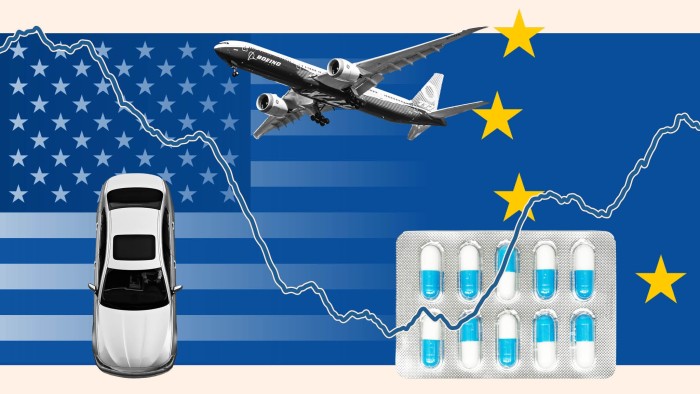Donald Trump’s threat to impose a 50 per cent tariff on all exports from the EU would deliver a hammer blow to key manufacturing sectors, including autos, aerospace, chemicals and other goods.
The US is the EU’s largest single trade partner, accounting for just over 20 per cent of goods exports worth more than €530bn in 2024, according to figures from the European Commission.
Germany, Ireland, Italy and France are the leading exporters by country. This include more than €200bn of machinery and vehicles, €160bn of chemicals and €25bn of food and drink.
Maria Demertzis, the head of the economy strategy centre at the Conference Board think-tank in Brussels, said the impact of a 50 per cent tariff would be “unsustainable”, particularly for exposed sectors where the US was a key market.
Economic modelling conducted when Trump imposed a 20 per cent tariff last April estimated that the tariffs would hit the bloc’s GDP by 0.2 per cent. This would grow to 0.5 per cent if 50 per cent tariffs were imposed, Demertzis added.
“It’s still a relatively small overall macroeconomic effect, although it will be large in some countries, like Ireland, [which] are more reliant on exports to the EU,” said Demertzis. In terms of sectors, “the effects will be very big indeed”, she added.
Pharmaceutical goods
Medicines were the most exported goods from the EU to the US in 2024, with almost €80bn drugs sold into the US market, according to Eurostat.
Nathalie Moll, director-general of the European Federation of Pharmaceutical Industries and Associations, said the group was “deeply concerned” about increased trade tensions between Europe and the US.
She warned tariffs would create shortages of medicines and urged the US and the EU to avoid them at “all costs”. “Tariffs on medicines would be nothing short of a disaster for patients and [the] industry on both sides of the Atlantic,” she said.
So far, pharmaceuticals have been excluded from the so-called reciprocal tariffs launched at the start of April, though Trump has launched a Section 232 probe into the national security implications of relying on foreign production. This could lead to tariffs on the sector.
European pharmaceutical companies such as Novo Nordisk, the Danish maker of obesity and diabetes drug Ozempic, and Sanofi, the French drugmaker, have significant domestic manufacturing. But US pharmaceutical companies have also built large manufacturing bases in the EU, particularly in Ireland, where they have taken advantage of a lower tax rate.
Trump has complained that Ireland has “got the entire US pharmaceutical industry in its grasp”. “We don’t make our own drugs, our own pharmaceuticals any more,” he said. “The drug companies are in Ireland and they are in lots of other places — China.”
Aerospace
Aerospace industry executives had already warned of higher costs as a result of Trump’s baseline 10 per cent tariff on almost all countries. The industry has since been lobbying the White House, arguing for a return to the tariff-free era that was largely been the status quo since 1979.
Both Boeing and Airbus import parts for new aircraft from various regions around the world. The US plane maker, which sources parts for its planes from countries such as Italy and Japan, is seen as particularly exposed to the Trump tariffs.
Even before Friday’s announcement, Ryanair — Europe’s largest low-cost airline and one of Boeing’s biggest customers — had warned it could delay deliveries of aircraft if tariffs made them more expensive.
Michael O’Leary, Ryanair chief executive, said this month that the airline was locked in a “debate” with Boeing over which side would pick up tariff costs.
Speaking on Friday before news of the tariffs broke, Guillaume Faury, Airbus chief executive, told an audience in London that “nobody wants to pay for tariffs”.
Autos
Car executives immediately lashed out at the failure of the EU to reach a deal with the US to lower the 25 per cent tariffs it has imposed on foreign-made vehicles and parts.
“The EU is becoming more hated than China, which is mind-boggling. The EU needs to come to the negotiating table with great urgency,” said Lynn Calder, chief executive of off-roader manufacturer Ineos Automotive, which makes its vehicles in France.
“Every other region in the world is mobilising, where is Europe? Their ‘do nothing’ strategy is failing.”
The car industry had been hopeful in recent weeks that Brussels and Washington would reach an agreement on car imports, especially after US reached a deal with the UK for a 10 per cent tariff rate.
The EU currently imposes a 10 per cent tariff on US car imports while the US only charges 2.5 per cent.
“I don’t think the US government is interested in closing down trade between Europe and the US,” Volvo Cars chief executive Håkan Samuelsson told the FT’s Future of the Car summit last week, saying the EU should “level” the tariffs to the same level as the US.
Oliver Zipse, BMW’s chief executive, also predicted earlier this month that Trump’s tariffs on foreign cars would be lowered from July.
It is unclear whether Trump’s proposed 50 per cent tariffs would be in addition to the existing 25 per cent duties on car imports, or in place of them. Duties in excess of 25 per cent would make car exports unviable for European manufacturers.
Higher tariffs would hit carmakers such as Audi and Porsche with no manufacturing footprint in the US, as well Volvo Cars, Mercedes-Benz and others that export vehicles sold in the US from Europe.
The US is the second-largest market for exports of EU vehicles after the UK. The EU exported 757,654 new vehicles to the US last year, valued at €38.9bn. It imported just 169,152 new vehicles from the US, worth €7.8 billion, according to European car industry body Acea.





